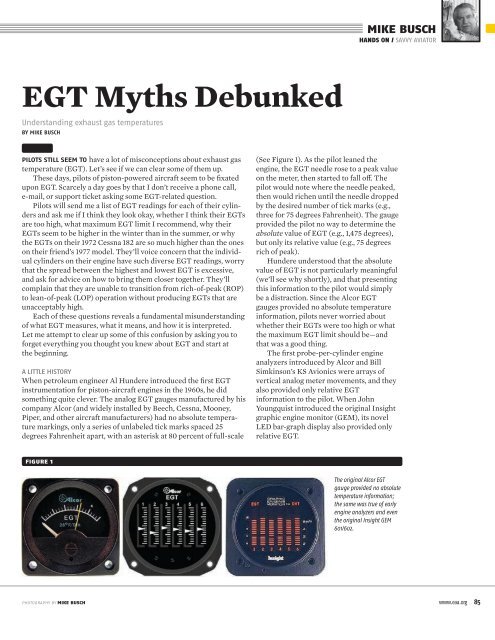EGT Myths Debunked
EGT Myths Debunked
EGT Myths Debunked
You also want an ePaper? Increase the reach of your titles
YUMPU automatically turns print PDFs into web optimized ePapers that Google loves.
<strong>EGT</strong> <strong>Myths</strong> <strong>Debunked</strong><br />
Understanding exhaust gas temperatures<br />
BY MIKE BUSCH<br />
PILOTS STILL SEEM TO have a lot of misconceptions about exhaust gas<br />
temperature (<strong>EGT</strong>). Let’s see if we can clear some of them up.<br />
These days, pilots of piston-powered aircraft seem to be fi xated<br />
upon <strong>EGT</strong>. Scarcely a day goes by that I don’t receive a phone call,<br />
e-mail, or support ticket asking some <strong>EGT</strong>-related question.<br />
Pilots will send me a list of <strong>EGT</strong> readings for each of their cylinders<br />
and ask me if I think they look okay, whether I think their <strong>EGT</strong>s<br />
are too high, what maximum <strong>EGT</strong> limit I recommend, why their<br />
<strong>EGT</strong>s seem to be higher in the winter than in the summer, or why<br />
the <strong>EGT</strong>s on their 1972 Cessna 182 are so much higher than the ones<br />
on their friend’s 1977 model. They’ll voice concern that the individual<br />
cylinders on their engine have such diverse <strong>EGT</strong> readings, worry<br />
that the spread between the highest and lowest <strong>EGT</strong> is excessive,<br />
and ask for advice on how to bring them closer together. They’ll<br />
complain that they are unable to transition from rich-of-peak (ROP)<br />
to lean-of-peak (LOP) operation without producing <strong>EGT</strong>s that are<br />
unacceptably high.<br />
Each of these questions reveals a fundamental misunderstanding<br />
of what <strong>EGT</strong> measures, what it means, and how it is interpreted.<br />
Let me attempt to clear up some of this confusion by asking you to<br />
forget everything you thought you knew about <strong>EGT</strong> and start at<br />
the beginning.<br />
A LITTLE HISTORY<br />
When petroleum engineer Al Hundere introduced the fi rst <strong>EGT</strong><br />
instrumentation for piston-aircraft engines in the 1960s, he did<br />
something quite clever. The analog <strong>EGT</strong> gauges manufactured by his<br />
company Alcor (and widely installed by Beech, Cessna, Mooney,<br />
Piper, and other aircraft manufacturers) had no absolute temperature<br />
markings, only a series of unlabeled tick marks spaced 25<br />
degrees Fahrenheit apart, with an asterisk at 80 percent of full-scale<br />
FIGURE 1<br />
PHOTOGRAPHY BY MIKE BUSCH<br />
MIKE BUSCH<br />
HANDS ON / SAVVY AVIATOR<br />
(See Figure 1). As the pilot leaned the<br />
engine, the <strong>EGT</strong> needle rose to a peak value<br />
on the meter, then started to fall o� . The<br />
pilot would note where the needle peaked,<br />
then would richen until the needle dropped<br />
by the desired number of tick marks (e.g.,<br />
three for 75 degrees Fahrenheit). The gauge<br />
provided the pilot no way to determine the<br />
absolute value of <strong>EGT</strong> (e.g., 1,475 degrees),<br />
but only its relative value (e.g., 75 degrees<br />
rich of peak).<br />
Hundere understood that the absolute<br />
value of <strong>EGT</strong> is not particularly meaningful<br />
(we’ll see why shortly), and that presenting<br />
this information to the pilot would simply<br />
be a distraction. Since the Alcor <strong>EGT</strong><br />
gauges provided no absolute temperature<br />
information, pilots never worried about<br />
whether their <strong>EGT</strong>s were too high or what<br />
the maximum <strong>EGT</strong> limit should be—and<br />
that was a good thing.<br />
The fi rst probe-per-cylinder engine<br />
analyzers introduced by Alcor and Bill<br />
Simkinson’s KS Avionics were arrays of<br />
vertical analog meter movements, and they<br />
also provided only relative <strong>EGT</strong><br />
information to the pilot. When John<br />
Youngquist introduced the original Insight<br />
graphic engine monitor (GEM), its novel<br />
LED bar-graph display also provided only<br />
relative <strong>EGT</strong>.<br />
The original Alcor <strong>EGT</strong><br />
gauge provided no absolute<br />
temperature information;<br />
the same was true of early<br />
engine analyzers and even<br />
the original Insight GEM<br />
601/602.<br />
www.eaa.org 85
MIKE BUSCH<br />
FIGURE 2<br />
86 Sport Aviation October 2010<br />
EI’s US-8 Ultimate Scanner displays absolute digital <strong>EGT</strong> information, as does<br />
JPI’s EDM-700, and subsequent generations of digital engine monitors have<br />
all done the same.<br />
Things started getting confusing when Electronics International<br />
(EI) introduced its Ultimate Scanner that provided digital (rather<br />
than graphical) readouts of <strong>EGT</strong>, and touted its 1-degree Fahrenheit<br />
accuracy as being far superior to the 25-degree granularity of the<br />
GEM’s bar graph. (Never mind that the absolute <strong>EGT</strong> values it was<br />
reporting so accurately were essentially meaningless.) Not to be<br />
outdone, J.P. Instruments (JPI) introduced its EDM-700 that featured<br />
both a GEM-like bar graph and an Ultimate Scanner-like<br />
digital readout on the same instrument (See Figure 2). The EDM-<br />
700 was a smashing market success and forced both EI and<br />
Insight to respond with similar products (the UBG-16 and GEM<br />
610, respectively).<br />
Now pilots were being presented with precise digital values of<br />
absolute <strong>EGT</strong>, scary temperatures in the 1,300s, 1,400s, 1,500s, and<br />
even 1,600s Fahrenheit. Few understood what these temperatures<br />
meant, but most assumed that—as with most other temperatures in<br />
aviation (cylinder head temperature, turbine intake temperature,<br />
outside air temperature, oil temperature, etc.)—cooler was better<br />
and hotter was worse.<br />
WHAT <strong>EGT</strong> IS NOT<br />
In fact, however, absolute values of <strong>EGT</strong> are not particularly interesting<br />
for a number of reasons. The most important is that indicated<br />
<strong>EGT</strong> is not a “real” temperature. To understand what I mean by this,<br />
PHOTOGRAPHY BY MIKE BUSCH
I’d like you to conduct a thought experiment:<br />
Imagine that you’re an <strong>EGT</strong> probe,<br />
located in an exhaust riser between 2 and 4<br />
inches from the exhaust port of a cylinder,<br />
and think about what you would see.<br />
As Figure 3 illustrates, you’d see nothing<br />
much two-thirds of the time—during most<br />
of the intake, compression, and power<br />
strokes—because the exhaust valve is closed<br />
and so no exhaust gas is fl owing out of the<br />
exhaust port and past the probe. During the<br />
one-third of the time that the exhaust valve<br />
is open, you’d see a constantly changing gas<br />
temperature that starts out very hot when<br />
the valve fi rst opens but cools very rapidly as<br />
the hot compressed gas escapes and<br />
expands, and then ultimately is scavenged<br />
by cold induction air during the valve overlap<br />
period (at the end of the exhaust stroke<br />
and the beginning of the intake stroke) when<br />
both intake and exhaust valves are open<br />
simultaneously.<br />
Now, all these gyrations are happening<br />
about 20 times per second, and you (the<br />
<strong>EGT</strong> probe) cannot possibly keep up with<br />
them. You wind up stabilizing at some temperature<br />
between the hottest and coolest gas<br />
temperature you see, and you dutifully<br />
report this rather arbitrary temperature to<br />
the panel-mounted instrument, where it is<br />
displayed to the pilot as a digital value accurate<br />
to 1 degree. The temperature you report<br />
to the pilot is not exhaust gas temperature<br />
(which is gyrating crazily 20 times a second),<br />
but rather exhaust probe temperature<br />
(which is stable but related to actual exhaust<br />
gas temperature in roughly the same fashion<br />
as mean sea level is to high tide).<br />
To make matters worse, numerous factors<br />
can a� ect indicated <strong>EGT</strong> besides actual<br />
exhaust gas temperature. These include<br />
probe mass and construction (grounded or<br />
ungrounded), cam lobe profi le, lifter leakdown<br />
rate, valve spring condition, and<br />
exhaust manifold topology, among others.<br />
For example, the two front cylinders (No.<br />
5 and No. 6) on the left engine of my Cessna<br />
T310R always indicate lower <strong>EGT</strong>s than the<br />
TURBINE INLET TEMPERATURE (TIT)<br />
Turbocharged engines are often equipped with<br />
a turbine inlet temperature (TIT) gauge or a TIT<br />
probe connected to the aircraft’s digital engine<br />
monitor. Unlike <strong>EGT</strong>, absolute values of TIT are<br />
meaningful, because the TIT probe is mounted<br />
far downstream in the exhaust system where<br />
the gas fl ow past the probe is steady (not<br />
pulsed) and has relatively steady temperature<br />
(not constantly fl uctuating). Observance of an<br />
absolute TIT redline (typically 1,650 degrees<br />
or 1,750 degrees) is appropriate and prudent<br />
to obtain maximum useful life from the<br />
turbocharger.—Mike Busch<br />
other four cylinders. The exact same<br />
phenomenon also occurs on the right<br />
engine. This is not because those front<br />
cylinders produce cooler exhaust gas than<br />
their neighbors (they don’t), but because the<br />
exhaust risers for those cylinders curve aft<br />
www.eaa.org 87
FAA-PMA Manufacturer of Quality Aircraft Parts<br />
888.750.5244<br />
www.mcfarlaneaviation.com/EAA<br />
Dual Controls for 912/914 Rotax Engines<br />
Clean installation without a clunky splitter box!<br />
Choke Controls<br />
Turn-to-lock and non-locking styles<br />
Many knob options<br />
Throttle Controls<br />
Panel mount with friction lock and quadrant styles<br />
Convenient mounting hardware and cable stops<br />
Push-to-Unlock and Turn-to-Lock Controls<br />
Heavy duty for strength and long life<br />
Many knob and length options<br />
Custom marking available<br />
New!<br />
Flight Control Cables and Engine Controls<br />
Custom made to your requirements<br />
Same high quality as our FAA-PMA products<br />
Quick turn-around<br />
Cowl Saver Baf� e Seal Material<br />
Reduce Airframe Vibration and Stop Cowl Damage<br />
Free sample!<br />
You can feel the difference!<br />
10 times less friction<br />
View demo: www.mcfarlaneaviation.com/cowlsaver<br />
McFarlane Aviation Products<br />
696 East 1700 Road, Baldwin City, Kansas 66006<br />
Ph: 785.594.2741 Fax: 785.594.3922 sales@mcfarlaneaviation.com<br />
88 Sport Aviation October 2010<br />
MIKE BUSCH<br />
FIGURE 3<br />
An <strong>EGT</strong> probe “sees” a rapidly changing gas temperature during the one-third of the time that the exhaust valve is open,<br />
and nothing much during the two-thirds of the time that the exhaust valve is closed. Thus, <strong>EGT</strong> indicated by a digital<br />
cockpit gauge is not a “real” gas temperature.<br />
FIGURE 4<br />
#1<br />
#2<br />
#3<br />
#4<br />
1,600˚F<br />
1,500˚F<br />
1,400˚F<br />
TDC<br />
Piston<br />
Position<br />
BDC<br />
4,000˚F<br />
Instantaneous<br />
Combustion<br />
Temperature<br />
0˚F<br />
2,000˚F<br />
Indicated <strong>EGT</strong><br />
Instantaneous<br />
Exhaust Gas<br />
Temperature<br />
0˚ 180˚<br />
Crankshaft Rotation<br />
360˚ 540˚ 720˚<br />
Intake<br />
Exhaust<br />
Valve Closes<br />
Intake<br />
Compression<br />
Ignition<br />
Intake<br />
Valve<br />
Closes<br />
Compression<br />
Power<br />
Exhaust<br />
Valve Opens<br />
Power<br />
Exhaust<br />
Intake<br />
Valve<br />
Opens<br />
Exhaust<br />
Exhaust Valve Closed Exhaust<br />
Valve<br />
Open<br />
0˚ 180˚ 360˚<br />
Crankshaft Rotation<br />
540˚ 720˚<br />
The spread between absolute <strong>EGT</strong> indications (depicted as “DIFF” on some digital engine monitors) is not important. What is<br />
important is the spread between fuel fl ows where the various cylinders achieve peak <strong>EGT</strong> (known as the “GAMI spread”).<br />
Richest<br />
Cylinder<br />
Peak <strong>EGT</strong><br />
DIFF<br />
(LOP)<br />
DIFF<br />
(min)<br />
Leanest<br />
Cylinder<br />
Peak <strong>EGT</strong><br />
DIFF<br />
(ROP)<br />
LOP ROP<br />
GAMI Spread<br />
13 GPH 14 GPH 15 GPH 16 GPH<br />
CHARTS COURTESY OF MIKE BUSCH
while the other four risers go straight down. Thus,<br />
the gas fl ow past the <strong>EGT</strong> probe is di� erent for the<br />
front cylinders than for the others, and their<br />
indicated <strong>EGT</strong> is lower. This temperature anomaly is<br />
quite obvious on my digital engine monitor—and also<br />
quite meaningless.<br />
WHAT <strong>EGT</strong> MEANS<br />
Even if indicated <strong>EGT</strong> accurately reported actual<br />
exhaust gas temperature (which it doesn’t), it’s<br />
important to understand that exhaust gas temperature<br />
does not correlate with stress on the engine the<br />
way cylinder head temperature does. In fact, many<br />
things that increase engine stress (such as advanced<br />
ignition timing and high compression ratio) cause<br />
<strong>EGT</strong> to go down, while things that reduce engine<br />
stress (like retarded ignition timing and low compression<br />
ratio) cause <strong>EGT</strong> to go up.<br />
Remember that CHT mainly refl ects what’s going<br />
on in the cylinder during the power stroke when the<br />
cylinder is under maximum stress from high internal<br />
temperatures and pressures, while <strong>EGT</strong> mainly<br />
refl ects what’s going on during the exhaust stroke<br />
after the exhaust valve opens and the cylinder is<br />
under relatively low stress.<br />
High CHTs often indicate that the engine is under<br />
excessive stress, which is why it’s so important to limit<br />
CHTs to a tolerable value (no more than 400 degrees,<br />
preferably 380 degrees or less). By contrast, high<br />
<strong>EGT</strong>s do not indicate that the engine is under excessive<br />
stress, but simply that a lot of energy from the fuel<br />
is being wasted out the exhaust pipe rather than being<br />
extracted in the form of mechanical energy.<br />
For instance, a 1972 Cessna 182 with an O-470-R<br />
engine will typically have indicated <strong>EGT</strong>s that are 100<br />
degrees hotter than those seen in a 1977 Cessna 182<br />
with an O-470-U engine. The -R has a relatively low<br />
7.0-to-1 compression ratio because it was certifi cated<br />
for 80-octane avgas, while the -U engine has a much<br />
higher 8.6-to-1 compression ratio because it was<br />
certifi cated for 100-octane. Because the highcompression<br />
-U engine is signifi cantly more e� cient<br />
at extracting heat energy from the fuel, it wastes less<br />
energy out the exhaust and thus its <strong>EGT</strong>s are cooler<br />
(despite the fact that the -U engine is much more<br />
highly stressed than the -R).<br />
High <strong>EGT</strong>s do not represent a threat to cylinder<br />
longevity the way high CHTs do. Therefore, limiting<br />
<strong>EGT</strong>s in an attempt to be “kind to the engine” is simply<br />
misguided.<br />
DIFF VERSUS GAMI SPREAD<br />
Right behind the “high <strong>EGT</strong>s are bad” myth is the<br />
“identical <strong>EGT</strong>s are good” myth. Many pilots believe<br />
www.eaa.org 89
MIKE BUSCH<br />
90 Sport Aviation October 2010<br />
incorrectly that a fl at-topped graphic engine monitor display (with<br />
all <strong>EGT</strong>s equal) is the mark of a well-balanced engine, and that<br />
unequal <strong>EGT</strong>s are a sign that something is wrong. This common<br />
misconception tends to be reinforced by digital engine monitors that<br />
display a digital “DIFF” showing the di� erence between the highest<br />
and lowest <strong>EGT</strong> indication.<br />
As illustrated by the earlier anecdote about the front cylinders on<br />
my Cessna T310R, di� erences between absolute <strong>EGT</strong> values are both<br />
normal and benign. It is not uncommon for well-balanced fuelinjected<br />
engines to exhibit <strong>EGT</strong> spreads of 100 degrees, and<br />
carbureted engines often have spreads of 150 degrees or more. In<br />
fact, as shown in Figure 4, <strong>EGT</strong> spreads are usually smallest near or<br />
just rich of peak <strong>EGT</strong> (the worst place to operate the engine), and<br />
often signifi cantly greater at leaner or richer mixtures (that are<br />
much kinder to the engine).<br />
The mark of a well-balanced engine is not a small <strong>EGT</strong> spread<br />
(“DIFF”), but rather a small “GAMI spread”—defi ned as the<br />
di� erence in fuel fl ows at which the various cylinders reach peak<br />
<strong>EGT</strong>. Ideally, we would like to see this spread be no more than about<br />
0.5 gph (or 3 pph). Experience shows that if the GAMI spread is<br />
much more than that, the engine is unlikely to run smoothly with<br />
LOP mixtures.<br />
IT’S ALL RELATIVE<br />
Al Hundere had it right after all: The only<br />
important thing about <strong>EGT</strong> is its relative<br />
value: how far below peak <strong>EGT</strong> and in which<br />
direction (e.g., 100 degrees ROP or 50<br />
degrees LOP). Absolute values of <strong>EGT</strong> (e.g.,<br />
1,475 degrees) are simply not meaningful<br />
and are best ignored. There is no such thing<br />
as a maximum <strong>EGT</strong> limit or redline, and trying<br />
to keep absolute <strong>EGT</strong>s below some<br />
particular value—or even worse, leaning to a<br />
particular absolute <strong>EGT</strong> value—is simply<br />
wrongheaded. Don’t do it. If you must fi xate<br />
on those digital engine monitor readouts,<br />
fi xate on something important, like CHT.<br />
Mike Busch, has been a pilot for 44 years, logging more<br />
than 7,000 hours. He’s a certifi cated fl ight instructor and an<br />
airframe and powerplant mechanic with inspection authorization.<br />
Log in to join Mike for a webinar titled “Say No to<br />
Useless Maintenance” on November 9 at 7 p.m. CDT at<br />
www.EAA.org/webinars.






